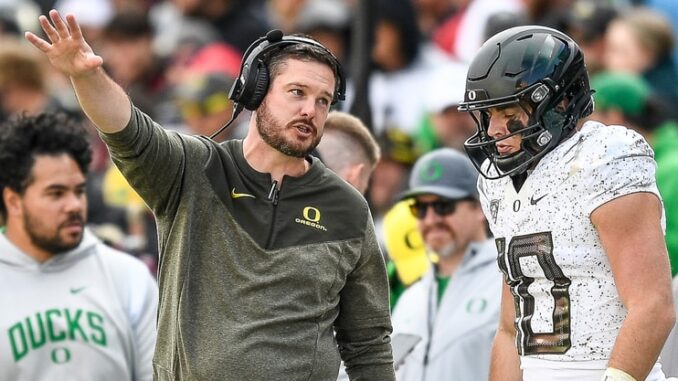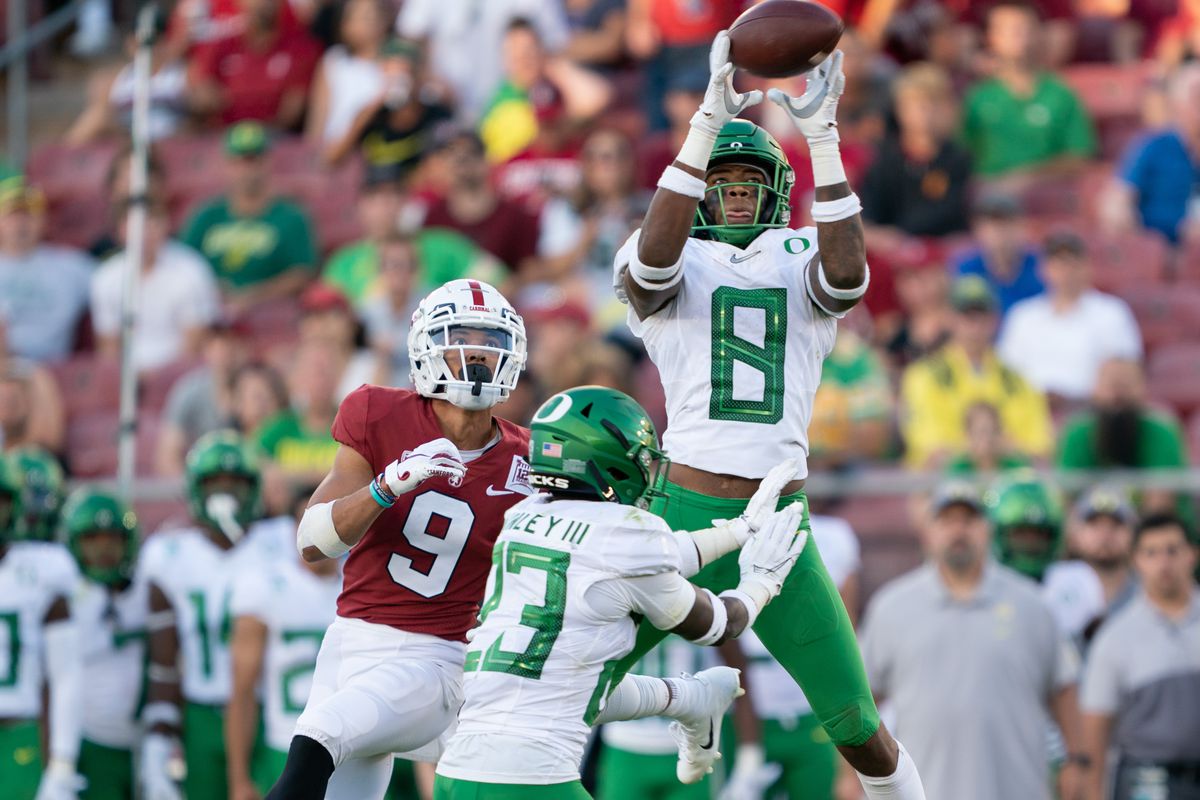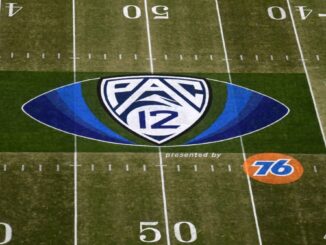
The sports countryside is blossoming with so many football rankings that many fans don’t think we need another. I feel that way also, but I’ve been doing my ranking system (Savvy Index) for so many years that I can’t help myself.
To me, rankings are entertainment. I focus on predicting games during the season and doing it more accurately than the bookmakers.
Consider it my job to search trend lines and composites to find reasons why the system says what it says. Of course, I don’t agree with all of the predictions, but Savvy Index completed a clean sweep of the bookmakers when it came to predicting game winners, point spreads, and total game points, so I’ve learned not to argue too strenuously.
Before discussing PAC-12 teams in particular, there are two primary characteristics that I will mention now as a general overview of the Conference.
- There is no conference anywhere with as many elite passing quarterbacks as the PAC-12. We saw it last year, and we will see it again this year.
- There is now Power Five conference in the nation with as many lousy pass defenses among its contenders as the PAC-12.
Wait.
Which is it? Are the quarterbacks that good, or are the pass defenses that bad?
It’s like answering whether it was the chicken or the egg that came first, to which I’ll answer — both. They are one and the same thing, just in different stages of development.
So it is with PAC-12 passing proficiencies. If the PAC-12 had lesser quarterbacks, pass defenses would look better, and if pass defenses were better, PAC-12 quarterbacks wouldn’t look as good.
Not every PAC-12 team has a lousy pass defense, but the blight among PAC-12 title contenders is concerning. The quarterbacks who are ready to take their teams to the national playoff will find it difficult if pass defenses don’t improve dramatically.
Speaking of PAC-12 teams getting into “the ‘natty,” let’s remember that this Conference was next to the last in bowl-win percentage last season. If the Conference couldn’t win common bowl games, why would we think they would suddenly win the national championship?
Fix those defenses, then let’s talk.
You can see national rankings for all 133 FBS teams here, but for now, let’s take a look at just the PAC-12 Conference.
1. UTAH — national rank: 6
It’s hard to argue against the Utes being the top team after they won the Conference championship in both of the past two years, and they demolished their closest rival, USC, 47-24 in that Conference title game. It was the third straight win by Utah over USC.
Utah also returns the second-longest tenured coach in Kyle Whittingham, and both of their coordinators. Also returning is two-year starting quarterback, Cam Rising behind an offensive line that returns two-deep with effective experience.
That line ranked tenth nation last year for opening holes for running backs, and it ranked in the top 20 for pass protection.
The primary area of concern for Utah is shoring up a pass-efficiency defense that was in the bottom half of the nation last year. But sometimes, the bad news is not all that bad because most of the PAC-12 pass defenses ranked in the bottom half. Utah’s pass defense will be good enough to win the PAC-12 but less likely to win the ‘natty.
2. Oregon — national rank: 8
Oregon’s offense will be a lot of fun to watch in 2023 with the return of quarterback Bo Nix and an enviable group of speedy and talented new receivers. Mix in the return of three running backs from a unit that was sixth in the nation for yards-per-carry, and you’ve got skill players that can put up more than 40 points per game.
It must also be noted that Oregon’s quarterback situation is rated noticeably higher this year because of the emergence of freshman Austin Novosad. The likelihood of Oregon continuing at a high level is better because if Nix goes down with an injury like he did last year, Oregon has a capable replacement.
Oregon’s offensive line has some new starters but, like Utah, the Ducks were two-deep in offensive line experience last year, and that means there is plenty of game experience returning. Offensive line recruiting has been strong and deep to the point where the OL unit has become nearly plug-and-play.
Defense?
Well, here we go again.
The Duck pass defense was nowhere near playoff level in 2022. It ranked 106th for completion percentage, 102nd for most yards allowed per game (256), and 123rd for sacking opposing quarterbacks.
Why?
Well, despite having an elite corps of linebackers, the Ducks were in the bottom ten of the entire nation for bringing pressure. Since then, there has been major attrition among the linebacking group, and that means new faces in the middle of a defense that was already underperforming.
The Duck rush defense was better but still below average in the nation. When you consider that UTEP, California, Rutgers, Arkansas State, UNLV, New Mexico State, and others ranked higher against the run, then you know the Ducks have a lot of work to do if they are to move into national contention.
So here’s my advice.
Yell your lungs out when Oregon has the ball, and drain your bladders when they don’t. Rejoice if the Ducks defend their PAC-12 North title because the likelihood of that is much less than it was a year ago.
My Savvy system projects 11 regular season wins for Oregon. I suppose without Georgia on the schedule, that is a decent estimate, but I personally think 10 wins might still be a bit on the optimistic side.
Washington — national rank: 13
There is a great deal of excitement in Seattle after last year’s 11-win performance by the Huskies and the subsequent announcement that Heisman candidate quarterback Michael Penix Jr. is returning.
Even better, offensive coordinator Ryan Grub snubbed an offer from Alabama, and he is back. The importance of Grub’s return cannot be understated because he not only engineered an 18-point increase in UW scoring last year, but his relationships with players are among the best in all of college football.
Like other Conference contenders, UW has plenty of work to do on defending the pass, but unlike others, the Huskies were magnificent in stopping ball carriers.
Okay, so wait a minute. Oregon and Washington are comparable, except that UW defends the run better, yet Oregon is ranked ahead of Washington? Why is that?
The biggest difference for Washington is that it faces a tougher schedule than it did last year, and the probabilities of once again hitting 11 wins are much less.
Instead of opening against five-win Kent State, UW opens this season against ten-win Boise State. Instead of Michigan State at home, the Huskies play Michigan State on the road. In crossover games with the PAC-12 South, the Huskies trade Arizona and Colorado from last year for games against Utah and USC this year.
That’s just a whole lot more challenges in 2023 than UW faced in 2022. With the likelihood of more losses comes a commensurate drop in rankings.
There are also some concerns with Washington’s interior offensive line, which graduated all three interior starters and won’t fill those positions with transfers. The Hawg-Dawgs were brilliant in protecting Penix last year but only average when it came to rush blocking.
With the graduation of leading running back Wayne Taulapapa and uncertainty in the OL, there is less reason to think UW will have enough of a ground game to leverage defenses.
4 USC — national rank 13
If you’re head coach Lincoln Riley, where do you go after your team scored more than 41 points per game last year? Well — up, of course.
USC may have the deepest and most talented group of offensive linemen in the country. The Trojans could lose its entire starting five and still have ten capable guys ready to play.
We all know that USC has last year’s Heisman winner in Caleb Williams and enough elite receivers to put up a spectacular number of yards through the air. The problem for Troy is that there is no proven replacement for Williams if he goes down with an injury. Considering that he is USC’s only experienced passer, the likelihood of USC continuing to contend if Williams goes down is minimal. Keep in mind that he is also one of the Trojans’ leading ball carriers, and that adds to the possibility of injury. Without Williams, the USC offense won’t scare anyone.
Leading rusher Travis Dye is gone, but Austin Jones is back after putting up 705 yards in a secondary role. And Marshawn Lloyd has transferred in from the other USC — South Carolina — where he led the Gamecocks in rushing and scored a touchdown once every dozen carries. The five-foot-nine, 212-pound battering ram averaged more than five yards per carry last season.
Like most of the PAC-12 contenders, USC will put up glossy numbers on offense.
That may be necessary because the Troy defense still doesn’t look like it can stop anyone.
Last year, the Trojan pass defense was 112th in the nation for giving up the most yards per game through the air. That is a stunning result when you consider USC was third in the nation when it came to pressuring quarterbacks. The problems weren’t up front for the Trojans. The problems were all on the back end, and there are not a lot of returners to that unit for 2023.
Stopping the rush was also disappointing for a team that fancies itself as a title contender. Opposing ball carriers racked up more than five yards per carry, and USC’s rush defense finished 94th in the nation.
The ingredients for reaching a higher bar this year are led by Caleb Williams not having any form of injury and the back end of the Troy defense finally figuring out how to cover somebody.
5 Oregon State — national rank 15th
If you think Oregon State is better than fifth in the PAC-12, you won’t get any argument from me. The differences in the top five PAC-12 teams are so small that any of them could win the Conference.
And that’s the point. It is a season of small differences, and OSU didn’t fare well in the “small difference” department last year. In three close games with Conference contenders, OSU came up short. Throwing eight interceptions in two of those games took the Beavers out of solid wins and into small losses.
Oregon State was 0-3 against teams ranked in the top 13. Two of those losses were by three points. But had the Beavers not thrown eight interceptions against those three frontrunners, they would have won two of those games by double digits.
Unlike the teams above, Oregon State played good defense against the pass. If that holds up and quarterbacks don’t throw interceptions, we can expect OSU to win those close games it lost last year.
I personally believe that will happen, and Oregon State will be in the mix for a lot of national attention. Although my system doesn’t agree, it at least is more gracious to the Beavers than Athlon, which ranks OSU 19th, or College Football News, which says this outfit will only win 7.5 games. My Index says 9.5 wins and a top 15 ranking.
6 UCLA — national rank 34
The likelihood of UCLA gathering enough new elements to compete for the PAC-12 crown is very low.
The Bruins are not about to win with their defense, and the offense must find replacements for a record-breaking quarterback and one of the best running backs ever to wear Bruin Blue.
Even if coach Chip Kelly replaces a host of openings among his starting skill players, there appear to be issues with offensive depth. Coming up with that much talent in one off-season is going to be pretty tough.
UCLA appears to be headed to a maximum of nine regular season wins and a final placement just outside of the top 25.
7. Washington State — national rank 60
There’s a lot to like about the Cougars. They return a proven quarterback in Cameron Ward and both of their top running backs. I’m not sold on new offensive coordinator Ben Arbuckle, who is trying to establish a long-ball passing game. That looks to be a risky venture because the WSU offensive line ranked 125th for giving up sacks last year, and that was in a short passing scheme.
Overall, the roster appears stronger this year than last. Depth at quarterback and fixing the offense line will determine if the Cougars rise above the seven-win season that is being projected.
8 Arizona State — national rank 73
At first, I was surprised to see Arizona State ranked this high because this program has malfunctioned and underperformed for years. Fixing issues created by the former coaching staff will take time.
However, my system has given a bigger bump upward than I expected for the hiring of new coach Kenny Dillingham. I also noticed that projected trend lines for the future are sharply inclined now that the drama and chaos of the former coaching staff have been removed.
Recruiting was abysmal under former head coach Herm Edwards, but Dillingham has created some sharp, upward spikes in recruiting trend lines in his short time in Tempe.
My Index never agreed with analysts who persisted that ASU was a title contender each year under Edwards. Although it is too soon to think the Sun Devils will challenge this year, trends suggest they will in 2024. But be consoled, ASU fans, because you will enjoy more wins and competitive football than you saw last season.
9 Stanford — national rank 92
Stanford was awful in 2022, and most of that was because recruiting high school players under former head coach David Shaw dropped like a pebble in a pond for four straight years. And, he never figured out how to make the transfer portal work for him.
Under new coach Troy Taylor, that is changing.
Taylor is a rare talent among head coaches. Consider In 2018, he resigned as offensive coordinator at Utah to take the head coaching job at Sacramento State, a program that had not won a single Big Sky football game that season. Three seasons later, Taylor was 23-1 against Big Sky competition, and his Hornets went all of the way to the final four last year.
We are likely to see Taylor run a West Coast style of offense to go with a 2-4-5 defense. Yes, that is an odd defense, but I’m not about to doubt Taylor again. I did that in my 2019 Sac State preview, and I’m still reluctant to show my face in Sacramento.
The quarterback situation on The Farm is not good and is a primary reason why this group is projected to get just three wins. However, I am keeping an out for a change in October, and if that happens, the likelihood of success increases to just under five wins.
10 Colorado — national rank 101
In a nutshell (and no, that’s not my term for Deion Sanders), this is as hard of a team to preview as any in the history of college football. There is a new coach who is both immensely bombastic and, to me at least, wonderfully entertaining. There is almost an entirely new roster.
I wish Deion well. I always have. But, I just don’t see the Colorado roster as a whole lot better than last year. Yes, the Buffs “won” the transfer portal recruiting, but with the exception of a few elite players at the top, the rest of the incomers appear equal to or less than the players who departed. Too many of the newcomers are from the FCS.
I don’t believe the roster is where we should be looking to determine success. Instead, I think it is Deion’s hiring of coordinators, especially on the defensive side with Mark Kelly, who was the defensive coordinator at Alabama for three years.
It has been evident to me that new head coaches who lure high-resume assistants usually do better than most people expect.
My Index projects Colorado to win 2.5 games.
11 Arizona — national rank 102
This ranking is a head-scratcher for me. U of A won five games last year and has some nice momentum and positive trend lines. I thought the Wildcats would be projected for 8th in the PAC-12 and in the 70s for national ranking.
Arizona finished 128th in pass-efficiency-defense last year. Even Colorado ranked higher. The ‘Cats gave up 45 points in four consecutive losses in the last half of last season and then lost its five top tacklers.
Jayden De Laura is a capable quarterback, but this offense will not get to a bowl game if he doesn’t cut his interception rate (3%). That will become even more difficult now that receiver Dorian Singer has transferred to USC.
Overall, the roster does not appear as strong as it did in 2023, and that is why Savvy Index is setting the win projection at three.
12 California — national rank 108
I haven’t seen any analysts or rankings that place Cal at the bottom of the PAC-12. My system does, and while I have trouble agreeing, I do see some of the reasons why.
Program trend lines at Cal are not good. Every year since 2019, Cal has dropped in the rankings, number of wins, and recruiting.
Every quarterback who threw a pass for Cal last year is gone.
If not for the transfer-in of former TCU starter Sam Jackson, this anemic offense would be unbearable for fans, especially with an offensive line that can’t seem to pick up blitzes.
However, Sam Jackson brings reasons for hope:
- He excels in composure under pressure.
- He runs the 40 in 4.65 seconds, something he will find is as useful as it is necessary.
Before anyone suggests that the Cal run game might take some heat off of Jackson, it won’t. It’s been four years since the Bear running attack finished above 90th in the nation in yards-per-carry.
Under head coach Justin Wilcox, Cal has prided itself in defense. But, the Bears ranked 88th in yards allowed per play last year, and that’s not enough to save this season.
If Jackson ignites and overcomes the odds stacked against him, this group may win three games.
All of these rankings are subject to change as information from summer workouts comes in, but those changes are expected to be minimal.




